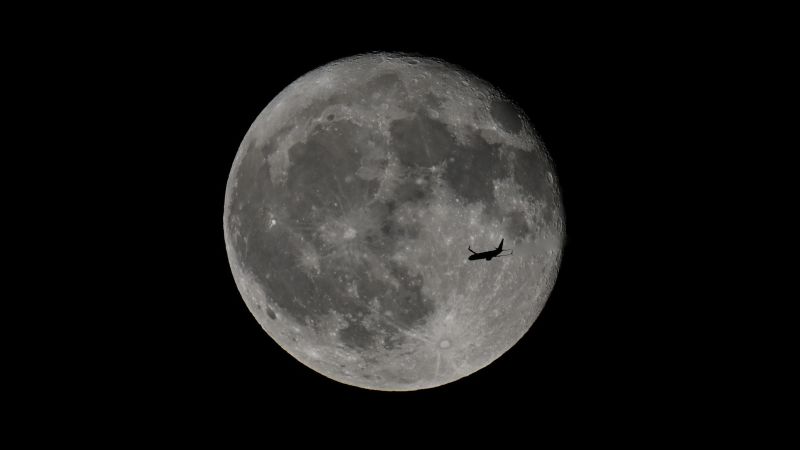The June full moon, often referred to as the “Strawberry Moon,” will be prominently visible on the night of Tuesday and into Wednesday morning. This yearly event is significant not just for its bright illumination but also for its cultural and astronomical importance. According to EarthSky, the moon will reach its fullest point at 3:44 a.m. ET on Wednesday. However, observers will still have the opportunity to witness its grandeur earlier in the evening, where it will rise low in the eastern sky after sunset on Tuesday, representing a beautiful celestial display.
Adding to the allure of June’s full moon this year is its coinciding with the summer solstice, which takes place on June 20. The summer solstice marks a time when the sun appears at its highest elevation in the sky. Because of this, the full moon appears lower on the horizon when observed from Earth; the moon and the sun are positioned on opposite sides of our planet. This unique arrangement creates a stunning contrast that sky watchers can appreciate as they gaze into the sky.
In an interesting twist, this year’s full moon is notable for being the lowest that Northern Hemisphere observers will see in decades, due to a rare celestial event known as a major lunar standstill. According to EarthSky, this phenomenon occurs when the moon reaches its northernmost or southernmost orbit position. The reason behind it lies in a slow gravitational pull from the sun, which alters the moon’s orbit over an extensive 18.6-year cycle. During this “standstill,” the moon seems to halt its directional path, although it continues its orbit around Earth, as detailed by the Griffith Observatory. Although the standstill event had occurred earlier in January, its effects on the appearance of the full moon continue to be felt.
For those located in the Southern Hemisphere, the situation is quite the opposite. Viewers there will see the full moon reaching its highest position, presenting a striking visual contrast to what will be experienced in the Northern Hemisphere. Interestingly, while the term “Strawberry Moon” might evoke thoughts of fruit, this name is rooted in the cultural traditions of various indigenous tribes. The Anishinaabe and Sioux tribes have named it for the sweet strawberries that ripen around this time of year. Other names include the “Blackberry Moon” as referred to by the Creeks and the “Raspberry Moon” attributed to the Shawnee tribe.
However, the June sky offers more than just the Strawberry Moon. NASA reports that the full moon will be positioned near the central region of the Milky Way, adding an astronomical spectacle to the night’s sky. This display will be part of “Core Season,” a period recognized from June through August when the bright center of the Milky Way galaxy is visible to the naked eye. Sky gazers can expect to see a faint, hazy band stretching towards the southern horizon, which becomes particularly vivid when captured via long-exposure photography. The most spectacular views will be reserved for those situated far from city lights, where light pollution would otherwise obscure the celestial beauty.
In addition to the full moon, June also promises a visible showcase of planets. After sunset, viewers can catch a glimpse of Mars, Jupiter, and Mercury appearing low in the western sky, while bright Venus can be seen low in the eastern sky for roughly two hours each morning before sunrise. A notable conjunction will occur on June 22 when Venus and the crescent moon will be located closely together in the early morning sky.
As we look forward to the remaining months of 2025, there are six more full moons to circle on your calendars, with special attention to potential supermoons occurring in October, November, and December. The Farmer’s Almanac lists these remaining full moons: the Buck Moon on July 10, the Sturgeon Moon on August 9, the Corn Moon on September 7, the Harvest Moon on October 6, the Beaver Moon on November 5, and finally, the Cold Moon on December 4.
In terms of upcoming celestial events, the fall will grace us with two significant eclipses. A total lunar eclipse will take place on September 7 and 8 and will be widely visible primarily across Europe, Africa, Asia, Australia, as well as portions of South America and Antarctica. This phenomenon occurs when Earth shadows the moon, causing it to appear dark. It may take on a reddish tint due to the light refraction that creates the often-invoked term “blood moon.” Following that, a partial solar eclipse is expected on September 21, visible in select remote areas, creating a stunning crescent effect where the moon overlaps the sun. This solar event illustrates the awe-inspiring beauty of our cosmos, reminding us how interconnected lunar and solar rhythms are.



